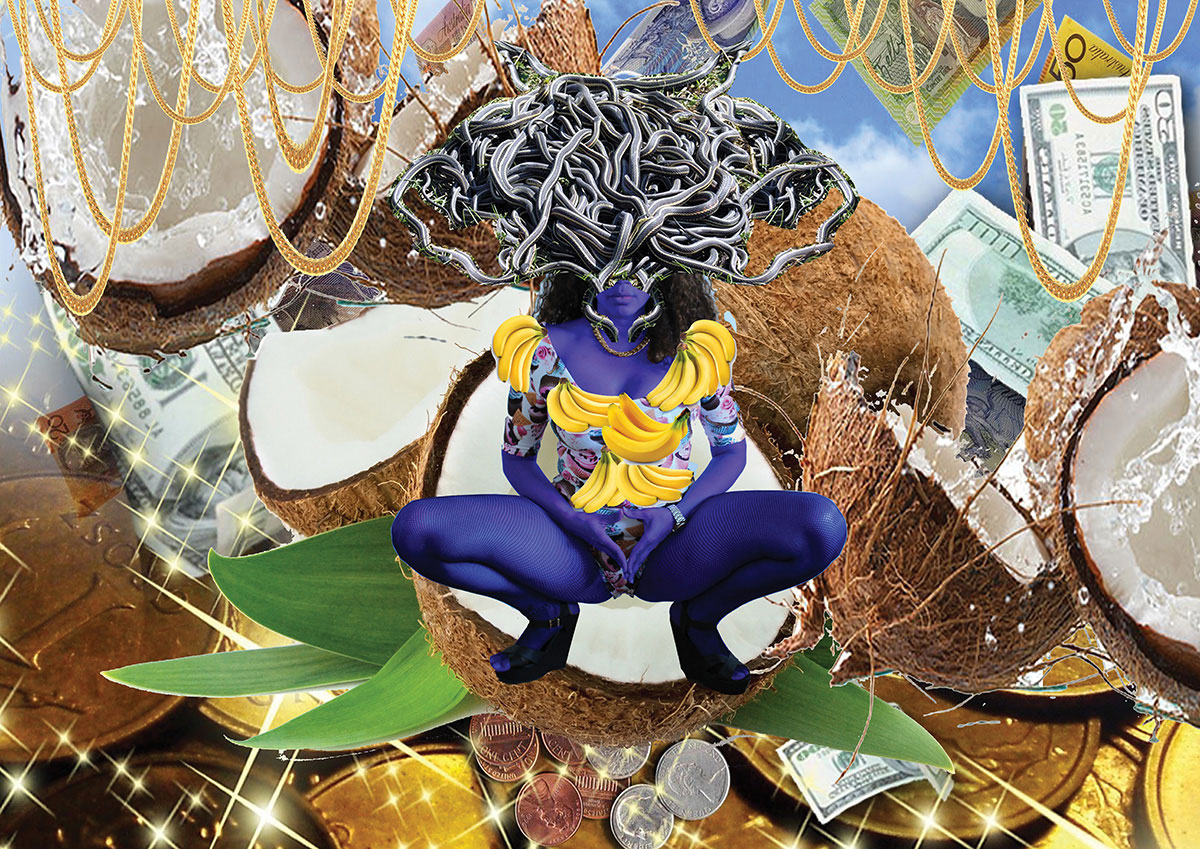Alberta Whittle uses digital collage to assemble objects and images that explore African-Carribean identity through masquerade and performance, often linking to the sea as a recurring theme. Whittle’s work is also concerned with lack of diversity and inclusion in the art world.
The suggested activities are designed to create situations that lead participants to better understand difference, reflect on barriers to inclusion and access, and consider the impact this has on their sense of self as well as their ability to participate in community.
These three tasks are designed to be completed as one activity.
Self Portrait Collage
Create a self portrait using photo-collage. Students have only 20 minutes to complete the task, and their self portraits don’t necessarily need to include their actual selves in the picture. Use old magazines, photographs (that you don’t mind cutting up), newspapers, posters, flyers etc. Alternatively students can do this using digital media. In this case encourage the use of any forms of digital visual media in addition to photographs.
The Water Tower Challenge
Split the group into smaller groups of 3-7 people. Group members must work together to construct a tower from the materials provided that is as high and stable as possible. The object is to build a tower that can support a cup of water at its peak. The tower must be both stable and strong, and be built as tall as possible.
However, in addition, each student is randomly assigned (or sensitively ascribed) a ‘barrier to inclusion’. Barriers may include, but are not limited to:
- Vocal: you cannot use your voice
- Mobility: you must be seated in the same position
- Use of hands: one or both of your hands cannot be used
- Stability: you must leave your group half way through to join another group
- Auditory: you cannot hear (use ear defenders or headphones with whitenoise)
- Steps: you must operate from a seated position on the floor (movement is ok)
- Visual: you cannot use your full eyesight (wear a blind fold or glasses that obscure vision)
- Immobility: you must keep moving throughout activity
You will need: Sellotape/masking tape, newspaper, scissors, cups, water (or marbles).
Students have just 10 minutes (timings can vary according to group needs) to construct the tower, each operating within the means of the barriers to inclusion. To test the strength and stability of each of the group’s towers, the facilitator will place a cup of water at the top to see if it balances. If it balances unsupported, the facilitator can then test the tower’s stability by giving the table a gentle nudge. Students that don’t want to get wet should stand back! Or marbles may be used in place of water.
After the task has been completed, ask students to consider the following questions in their groups:
- Did individuals experience the same barriers differently?
- Did some barriers seem insurmountable?
- When did you work together, and when did you work alone?
- What encouraged you to persevere?

Self Portrait Collage (with barriers to inclusion)
The third and final activity combines elements from the previous two. Once again, ask students to create a self portrait using photo-collage from the magazines and other print materials, this time activating within the barriers to inclusion ascribed to them in the previous task.
Prompts for discussion that might be asked after each task or at the end:
- In this brief experience, how did this additional barrier to inclusion make you feel?
- These barriers centred on physical barriers. How might other barriers in society, such as structural or systemic barriers, contribute to the illusion of inclusion?
- How might your understanding of barriers to inclusion change the way in which you create your work or share it with others?
- What does this teach us about intersectional* understanding?
How can our learning from this help us gain greater understanding about what needs to change in terms of access and inclusion in all forms of creative activity (for example in galleries or museums)?
*Intersectionality is a framework for understanding that we each have a unique experience of discrimination, privilege or disadvantage and that this and the things that can marginalise people such as gender, race, class, sexual orientation, disability are all connected.
Comments from the Contributor
I chose the piece I is for the Illusion of Inclusion because the work speaks to many themes that my own creative enquiries look toward. Access to inclusion is often presumed. I often ask myself “who isn’t here? Why aren’t they here? What barriers can be removed so they may be able to be present?”
Other artists our contributor thinks might inspire you
An artist that I admire and think that others should be aware of is Athi Patra Ruga, a South African artist who uses performance, photography, video, textiles, and printmaking to explore notions of utopia and dystopia, material and memory. His work explores the body in relation to sensuality, culture, and ideology, often creating cultural hybrid.
About the contributor
Tarik Elmoutawakil is an artist, programmer, creative producer as well as Founder and Co-Artistic Director at Marlborough Productions in Brighton, the UK’s only performing arts orgnasiation dedicated to intersectional queer arts. His current public work is entitled ‘Brownton Abbey’, an Afro-Futures Performance Party that centres disabled QTIPOC (queer, trans and intersex People of Colour). Brownton Abbey reclaims and reinterprets QTIPOC spirituality and ritual, channelling it into an out-of-this-world, accessible party.

